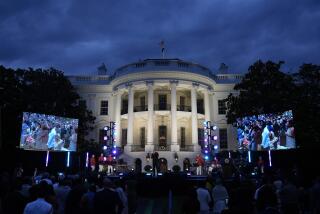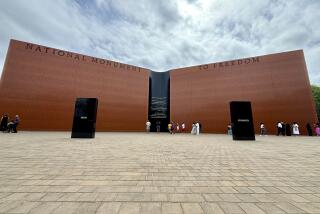‘A Long Way to Go’
- Share via
The Statue of Liberty, meticulously patched and fitted with a new flame, turns 100 this week. Through the years, the statue has been transformed from a symbol of fraternity between France and the United States into the pre-eminent symbol of freedom, a beacon for millions of immigrants and a patriotic symbol of unrivaled emotional intensity. It has inspired poetry and song, speechmaking and caricature. But mostly the statue has been a personal symbol, to millions around the world, of the hopes and promise of a nation that proclaims itself dedicated to individual liberty. Five very personal perspectives:
Rosa Parks was arrested in Montgomery, Ala., on the evening of Dec. 1, 1955, after she refused to give up her bus seat to a white man. The black seamstress’s act of defiance touched off a boycott of the city’s buses, led by the Rev. Martin Luther King. Now 73 and living in Detroit, Parks is an assistant to Rep. John Conyers (D-Mich.).
When I was coming up, I went to a one-room country school in Pine Level, Ala., where all the pupils and the teachers were black. In the sixth grade, my mother sent me to Montgomery, where I went to the Montgomery Industrial School, which was run by Miss Alice White. She was a very proper older woman who ran the school with a group of Northern white ladies who were sympathetic to the plight of Negroes. That’s what they called us back then.
In school, we learned all of the civics lessons that children were supposed to learn. We had to memorize Abraham Lincoln’s Gettysburg Address and portions of the Constitution. We recited the Pledge of Allegiance. We studied all of the Presidents--Washington, Jefferson, Lincoln--and we knew about all the wars.
I guess for most of us children, the Statue of Liberty was just something we read about in a civics book. We learned that poem about the statue, but it was just another lesson we had to recite, just like the Civil War poem about the Blue and the Gray, or the Gettysburg Address.
The Africans who came over on the slave ships never saw the statue. Of course, they didn’t mention that in the history books. The studies we did in our books were based on freedom and equality and the pursuit of happiness and all. But in reality we had to face the fact that we were not as free as the books said. What they taught us in school didn’t apply to us as a race. We were being told to be as submissive and as useful as possible to white people, to do their work and see to their comforts and be segregated from them when they saw fit for us not to be around.
Even Miss Alice White, who had all the best intentions in the world, was part of the system. In her lectures, she would tell us how horrible slavery was, but then she would say that at least it brought the Negro out of savagery in Africa. Of course, none of those slave traders ever asked the Africans whether they wanted to come to America. I imagine that if the Africans had come around after the statue was built, they would have had some terrible ideas about what it meant to them. I don’t think they would have written any poems.
My family knew the brutality and disillusionment of not being treated like human beings. My grandfather was a slave. He was the son of the plantation overseer, so he was very white in appearance. My grandfather used to say that the overseer took an instant dislike to him because he looked so much like him. He would always tell me how he had to dodge and hide to keep out of trouble with the overseer. Until the day he died, my grandfather had a fierce hatred of white people.
My mother had a mind of her own. She always held to the belief that none of us should be mistreated because of our race. She was pretty outspoken, and of course that didn’t endear her to too many whites. It didn’t endear her to too many blacks, either, because in those days the general attitude among our people was to go along in silence. If you differed with that, you had to stand pretty much alone.
I remember that one of the first books I read, back when I was 8 years old, was called “Is the Negro a Beast?” That was the kind of attitude that white people had in Alabama in those days. It was so different from what we were reading about in our American history and civics lessons, with all the positive messages about life in this country, and I could see that what we were being taught wasn’t so, at least as far as black people were concerned.
It didn’t change much when I was working. I encountered all kinds of discrimination. If you were black in the South, it was just something you lived with all the time. I would just meet it in silence, bite my lip, go on. I saw it a lot with the bus drivers. If they thought you were about to make trouble, they would just shut the door on you and drive on off. In fact, the same red-headed driver who arrested me in 1955 (starting the Montgomery bus boycott led by King) had evicted me from a bus in 1943. He didn’t want me to walk through the white section of the bus to get to the section for blacks, and I told him I wasn’t going to get off the bus while I was already on. He took me by the sleeve of my winter coat and led me off. When I got on his bus again 12 years later, I remembered him very well, but I didn’t expect him to disturb me a second time.
I didn’t actually get to see the Statue of Liberty until about a year after the boycott. By that time, my attitude was a little different. I thought that saying--”Give me your tired, your poor . . .”-- was impressive, that we should help people who come to the United States. This was a better place than where they had been.
I was invited to come to New York by Dr. Ralph Bunche and met him at the United Nations. I stayed with a Quaker couple, Mr. and Mrs. Stuart Meacham, who lived on Franklin D. Roosevelt Drive in Manhattan, right on the East River. Mr. Meacham asked me what was the first thing I wanted to do in New York. I told him, to see the Statue of Liberty. I had always been fascinated by tall buildings and monuments.
We went across the water by ferry about noon. It was just the way I thought it would be, that big arm waving the torch high above everything. We walked up all those stairs to the very top, right in the crown. We looked out from the windows in the crown, and we could see for miles. When we went back down, Mr. Meacham took my picture at the foot of the statue.
I guess the statue should be a symbol of freedom. I would not want our young people to be so disillusioned that they couldn’t feel a sense of awe about it. But I can’t find myself getting overwhelmed. We are supposed to be loyal and dedicated and committed to what America stands for. But we are still being denied complete equality. We have to struggle to gain a little bit, and as soon as it seems we make some gains for all our sacrifices, there are new obstacles, and people trying to take away what little we have.
Certainly there is a degree of freedom in America that we can celebrate, but as long as a difference in your complexion or your background can be used against you, we still have a long way to go.
More to Read
Sign up for Essential California
The most important California stories and recommendations in your inbox every morning.
You may occasionally receive promotional content from the Los Angeles Times.










